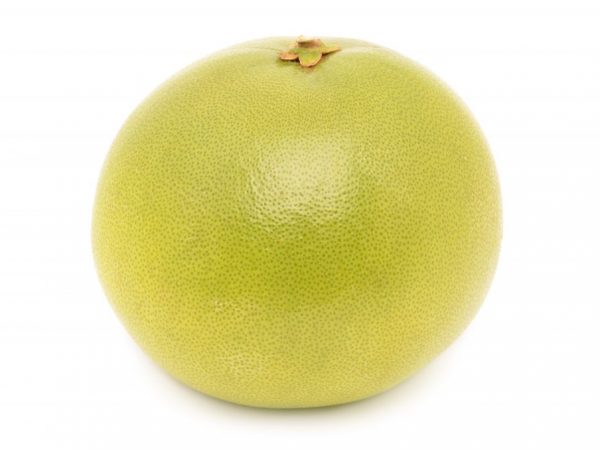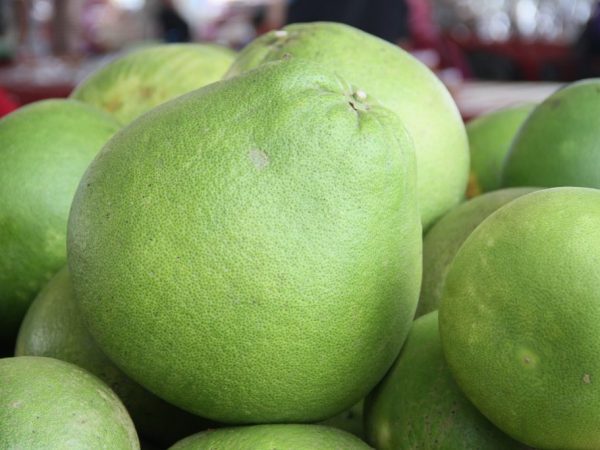Pomelo selection rules
The evergreen pompelus fruit plant produces large juicy fruits. It is a hybrid of orange and grapefruit. It is difficult to choose a pomelo in a domestic store, since the goods are imported still immature, and defects are almost invisible due to the thickened rind.

Pomelo selection rules
External quality criteria
The first step in choosing a ripe pomelo is a careful examination of the external data. Avoid buying fruit that has ring-shaped red streaks on its skin. Deep burgundy depressions signal fetal disease. By eating such a product, you can get serious poisoning.
Dents indicate the beginning of the decay process. The pulp is already rotting, but outwardly it is almost imperceptible. Such fruits taste sour, have a damp aftertaste.
Assessment of the peel
You can choose the right pomelo if you examine the condition of the skin. Citrus is grown in Asia and imported by several types of vehicles. On the way, fruits fall, rub against each other, favorable conditions are created for the development of rot. Inspection of the skin allows you to exclude the purchase of damaged fruits.
Skin condition of a healthy fetus:
- smooth, even structure, without dents, bumps, seals;
- uniform color, one side can be browned.
Green blotches are a sign of immaturity and unsafe growing. The fruit was removed from the branch too early or chemical fertilizing with nitrates was used. Too bright color of the peel also signals that the dosage of fertilizers is exceeded.
Structure and resilience
Delicious ripe fruit is firm, firm, dense in structure. The firmness of the pulp is felt even under a thick layer of rind. The fruits of medium density have already been dried, which means that the storage conditions were not met until the end or the products entered the store in this form initially and were not rejected.
In such cases, the palatability is markedly reduced. The pulp, when chewed, resembles cotton wool. Long-term storage at temperatures below 15 ° C dries up the fruit. It overripe, becomes tasteless, loses useful trace elements.
Fruits lose their properties when frozen. Choosing a pomelo fruit that has not been frozen is easy in terms of density. The citrus is too soft; when pressed, it leaves dents that acquire a brownish tint.
Varieties and their features

Ripe fruit gives off aroma
It will be possible to choose a high-quality pomelo, distinguished by high taste indicators, if you rely on the characteristics of the varieties. The sweetest fruit is the Honey Pomelo. The shape of the fruit is pear-shaped, the skin is thick and dense. The weight of a quality copy is at least 2 kg. The heavier the fruit, the more juice it contains.
The round, flattened variety should be selected by weight. The minimum weight of a quality fruit is 1 kg. The palatability is largely determined by the color inherent in the variety:
- green fruits are sweet and sour, with a refreshing note;
- bright yellow pear-shaped citruses are juicy, sweet;
- the peel of Kao Yao is distinguished by a high concentration of nutrients, the pulp has a spongy structure, white, sweet, with a refreshing sour note;
- Tong Di - small fruits with a thin skin for a pomelo (1 cm), the flesh is pink, sweet.
Ripe fruit of any variety exudes a distinct citrus aroma with a hint of bitterness. Felt in the distance.
The top of the fruit is resilient and of uniform structure
Storage periods
Unripe fruits should be kept in a refrigerator or a cool dark room. Unpeeled fruit is stored for 2-3 weeks. Shelf life of refined products:
- fresh pulp is eaten within 2-3 days;
- dried slices are stored in the refrigerator for 2 months.
Products will last longer if well ventilated. The shelf life reduces the placement of citrus next to other types of fruits: apples contribute to overripening.
Useful properties and contraindications
A good pomelo includes a large amount of antioxidants that improve the structure of the skin, lower blood cholesterol levels, fiber and fructose, and other useful components. Regular consumption of citrus improves health. The product belongs to the group of active fat burners and is recommended in the diet.
Citrus has contraindications for use:
- gastric diseases, with increased acidity;
- diabetes;
- acute renal and hepatic failure;
- age up to 3 years;
- intolerance to the product.
Useful Tips
There are a number of cases when it is better to refuse to buy fruits:
- products are wrapped in cling film - packaging hides defects, reduces shelf life;
- unnatural shine - the peel has been treated with chemicals (wax), a thick layer of peel does not prevent the penetration of harmful substances into the inner layers of the product;
- ripe delicious citrus is best bought in January-February;
- there is no citrus aroma - the fruit is immature or grown on chemical dressings.
Having seen several varieties of citrus on the shelves of the store, they take 2-3 fruits of different varieties. So it will be possible to calculate the most attractive fruit in terms of taste. Buying thick-skinned specimens is a waste of money. In reality, the weight of the peel is negligible in order to significantly affect the price, and the quality indicators are superior to the thin-skinned counterparts.
Conclusion
It is necessary to choose a pomelo based on several criteria. The main thing is to learn how to calculate the fruits processed with chemicals.


